America’s most beautiful city
Cavalier Charleston
‘Carolina is in the spring a paradise, in the summer a hell, and in the autumn a hospital.’ So apparently goes an old saying lamenting the region’s swampy heat, although when I arrived in early October after a gruelling 500 mile drive it was pouring with rain and colder than home. It could have been Wales, although everyone said this was unusual.
Charleston is South Carolina’s largest city and perhaps one that symbolises the Old South more than any other, part of a folkway of American life that David Hackett Fischer characterised as Cavalier, the antithesis to Roundhead Boston. It became, as historian George C Rogers wrote, ‘the centre of an idea, a southern way of life’ and throughout its history it has come to represent something both to lovers and haters - the centre of rebellion against northern rule but also a town once infamous for race-mixing, as well as a louche, rum-soaked oasis in a prohibitionist region.
Today it still stands as the centre of an idea, although a rather different and newer one, a dream of urbanism in a country which has forgotten how to make cities work. Set on a peninsula five square miles in size, between the Ashley and Cooper rivers, the town draws in a fair number of tourists, although it’s nowhere near the most visited in the US, and there are no direct flights from London anymore. My in-laws went there for a wedding a few years back and said it was the loveliest city they’d ever visited.
Some people don’t just visit but stay, among them my friend Ned Donovan, an Englishman with US citizenship through a grandparent. Ned worked for five years as a volunteer constable for the Metropolitan Police and has written about his experiences in London. He loves America, loves the people, and, after travelling around the country, fell for Charleston in particular. It was the most beautiful city he had visited, but he liked the vibe too: friendly, churchgoing, freedom-loving.
Ned now serves the police force on the Isle of Palms, just to the east of the city, where he’s not spat at or assaulted by scammers. Indeed, the people here treat officers with something bordering on reverence; as we drove along in the squad car, with me sat beside him wearing a blazer which I hoped made me look like a hard-bitten detective, some older people looked at us with obvious admiration.
They really see the police as their protectors here, he explains on a quiet Monday afternoon where, to my disappointment, we don’t get into any high-speed chases. It’s part of the culture, and people often also thank veterans ‘for their service’; men who have fought in combat are able to display their status on licence plates, including any medals they won. Because of its position as the main line of defence from the Caribbean, Charleston Naval Base was once the third largest in the country, and the city is still home to a military cadet force based at the Citadel.
It also has a large student population, and it’s full of, and there’s obviously no way for a 47-year-old man to say this in a way that doesn’t sound a bit creepy, beautiful college age girls with a very distinctive southern look: long curled hair, knee-high boots, incredibly good skin. Apparently, Charleston is home to far more young women than men, because the college has a large gender imbalance and the city lacks the high-paying jobs which attract ambitious young people from outside.
The southern accent certainly adds to the charm. At a bustling pub called, of all things Moe’s Bar, the bar-tender addresses us as ‘Hey y’all’. I think this is the first time I’ve ever heard this in real life, something which I have only ever seen in print and mostly from anxious left-wing academics on Twitter. The bar is showing four different college football games, including what is a local derby of sorts with a team from Georgia. These events draw crowds of 90,000 and people will pay up to four figures for a ticket, one of those incomprehensible American things foreigners can just never understand; imagine if half the England team had been admitted to Oxford first so that they could beat Cambridge.
Colleges are obviously quite central to American local identity in a way they aren’t to us. I’m also a great believer in the theory that many Americans idealise their time at university not just because they’re young and free, but because it’s the only time in life they’ll be in an urban setting where they can walk to their friend’s houses, often surrounded by beautiful traditional architecture, and safe from crime. That’s the environment which makes people happiest and healthiest, yet the overwhelming problem with American urban life is that Democrat-dominated cities are riddled with squalor, and more Republican cities, especially in the south, are built around cars. Any attempts to build the cities that people actually wish to live in are dismissed as ‘Disneyland’.
My initial plan was to get the night train from Washington, but the country’s rail network is quite basic, very slow and apparently always late, and the train arrives in North Charleston at 4.30am, the dangerous part of town outside of the peninsula, with no car rental spot nearby. The country’s lack of railway infrastructure is pretty frustrating for visitors, and historically bizarre considering that America was an early and enthusiastic adopter of the railroads, and once accounted for one-third of all miles of track (Charleston was also home to only the second railway line in the US). However, I appreciate that trying to convince Americans to abandon their cars is like trying to sell teetotal Islam to Slavs.
But this being America, you can always choose to live with like-minded people, and Charleston attracts many fans of urban living. On Sunday morning, I tweeted that I was in town, and through the power of international urbanist Twitter, in particular the great Wrath of Gnon, I was introduced to local architecture enthusiast Vince Graham.
Within an hour I was drinking coffee in Vince’s townhouse, talking about my favourite pet peeve, the destruction of urban Britain by town planners. The same thing happened to the US, of course, and they can’t even blame the Germans. (Someone on my trip joked that the Americans should issue warning broadcasts to any Middle Eastern country that angers them, with footage of Detroit and the chilling words ‘this is what we do to our own cities – imagine what we’ll do to the enemy’s’).
Conforming to stereotypes about southern hospitality, Vince sacrificed three hours of his morning to show me around the city’s beautiful streets and its pretty little alleyways. He showed me the new development of I’On across the river, which he had helped build and features family homes set in traditional American style, with especially charming canalside homes (I also note that it has a street named after Thomas Sowell – very pleasing).
In Charleston itself a surprising number of the old buildings he points out are only recently built, part of a new urbanist revival here, a story chronicled in Charleston Fancy. As I walk along the streets I notice numerous Amazon packages on doorsteps, a hugely positive sign.
Vince takes me to Catfiddle Street, a network of villas which looks like it was built in Renaissance Italy but dates to the 21st century. It took some time to convince the city to let them build it, he explains, and the fire department worried that they couldn’t fit their engines; everywhere, design codes punish aesthetics, but they got there in the end, and the results are clear to see. It’s really beautiful, even in the pouring rain.
As we walk around this Palladian maze of buildings, he talks about one of the architects, Reid Burgess, a mandolin player and bluegrass fan who previously lived in Brooklyn. ‘And this is Reid’s house’, he points out. Within a few minutes Reid is making us coffee as I wander around his exquisite living room. (How many modernist architects inhabit their creations, rather than choosing to live in Georgian houses quite unlike the designs they inflict on others?)
After leaving Vince, I stroll down Church Street - the city is famous for its abundance of old churches - and congregants from the various sects pour out, smart and attractive looking. South Carolina is the second most religious state in the US, and this is perhaps the most unusual thing to a British newcomer. Ned explains that what you first take as religious enthusiasm is just the default belief, nothing wacky or eccentric: ‘They just love Jesus here’.
The paradox is that, while this part of the South is more religious, it lacks the zeal of Yankeedom, whose crusading temperament has driven the country’s moral campaigns like a force of history, the latest incarnation being woke progressivism. Charleston was the one American city I saw where wealthy areas weren’t festooned with Pride colours, anti-Trump messages, Palestine flags or the Black Lives Matters motto, although I saw one church displaying the rainbow ‘this house believes’ declaration of faith - a Congregationalist church, fittingly. In most of America these flags are the symbols of the new ruling class, but wherever you see them, you will also see downtowns which are filled with the sort of squalor that makes city living miserable. Many urban Americans seem to accept or even like this, and feel that the edginess is what gives cities life - ‘if you’re tired of a crack addict screaming at you on public transport, you’re tired of life’ sort of thing. But it’s not for everyone, and especially not for people with young children.
While the Church of England was established before the revolution, South Carolina wore its religion more lightly than the Congregationalist colonies to the north. Historian Carl Bridenbaugh said that ‘Charles Town was probably the least religious’ of all the settlements in the colonies, and in A Short History of Charleston, Robert Rosen writes that Charlestown from the start ‘was a model of religious tolerance’.
In 1824 the first Reform Judaism congregation, Kahal Kadosh Beth Elohim, was set up, and after the depredations of 20th century Germany it is now the oldest in the world. Back in 1774 Francis Salvador had become the first Jew to be elected at a popular assembly in the colonies, here in Charleston, and two years later had the equally historic, although slightly more unfortunate, claim to be the first Jew killed fighting for American independence.
Larger in size were the Huguenots, whose old church can also be found on Church Street by the old French Quarter, an area filled with posh restaurants, galleries and indoor markets that would make a europoor weep. The French played a key part in the early city, many became very rich, and some of the great Huguenot names of colonial Charleston - Legare, Guerard, Gaillard, Laurens, Manigault, Mouzon, Prioleau and Ravenel, as Rosen lists them – are still found here.
The city also attracted large numbers of Irish and Germans – the latter accounting for one-third of the white population before the First World War – as well as Italians, Swedes, Syrians, Russians and Poles. Yet it is still dominated by the foundational American groups, Anglo-Celts and Africans, even if the black population is in decline - once a majority, they now comprise just 25 per cent (The Charleston dance is supposed to have come from the Gullah-speaking culture here and brought to Harlem in the Great Migration). The white people even look more noticeably British than in other parts of the United States (although this might just be my imagination, and there wasn’t enough room in my luggage for my callipers so I can’t be sure.)
America is a land of extremes and contradictions – many better writers from Europe have made this obvious observation – and the ‘Holy City’ has long been known for its its Cavalier attitudes to the seamier side of life. From the start, Charleston had a racecourse, christened Newmarket and the South Carolina Jockey Club was the city’s most venerable institution, while those boring Yankees focussed on wasting their time with universities. It was also famous for its undesirables - as early as 1702 there were women of ‘ill fame’ here – and gambling was common, although it was banned on the sabbath.
It was also pirate central - in 1718 alone, 49 of them were hanged here. The city was visited by such luminaries as Edward Teach, aka Blackbeard, who arrived in May that year with four ships and 400 men and took off with a number of vessels and locals. Then there was Stede Bonnet, the so-called Gentleman Pirate, who was finally caught in nearby Sullivan Island and hanged – his execution was delayed several times because he was so popular among Charleston’s women. (As much as Americans don’t need my advice on commercialising things, they really missed a trick with the whole Pirates of the Caribbean craze. I would have built a giant Pirateworld outside the city and watched the dollars flow in.)
It was also famous for its boozing, and Rosen points out that in one year in the 1900s Charleston received 213 of 297 liquor licenses in South Carolina. It was only in the 1970s that the rest of the state eased its prohibitive alcohol rules with ‘mini-bottle’ laws that allowed people to finally drink in bars and restaurants, as had always been the case in its largest city. This decadent reputation is partly why the city had come to epitomise everything the late 19th century populists hated, full of drunken aristocrats who had led the South to failure.
The charge might have had the ring of truth, and by this stage Charleston had long since lost its status as one of America’s major cities, having been the fifth largest back in 1800. Indeed, the whole region had started to fall behind long before the Civil War, and much of this was down to the contrasting cultures of the Cavaliers and their Roundhead rivals in New England. Rosen notes that between 1743 and 1760 Charleston published just 12 books; tiny Newport in Rhode Island published 77, New York 495 and Boston a whopping 1,321. While Charleston boasts a beautiful college on Philip Street, traditionally the local gentry would send their sons to Princeton, away from a region which didn’t prize intellectualism.
Another distinction was the contrasting regional attitude to guns and violence, and one of the most bizarre things to a visitor is the number of shops displaying signs warning customers not to bring in concealed weapons – even in posh restaurants. South Carolina has very permissive gun laws, and last year passed ‘Constitutional Carry’ which allows individuals to carry guns anywhere in the state without a permit, whether openly or concealed. People cherish their right to carry guns here, perhaps another of those England-frozen-in-aspic things that I find baffling. Not coincidentally, it has the fifth highest murder rate of all US states, and even broken down by race, white southerners are far more violent than those in the north, which Fischer put down to the Borderer psychology.
Yet this being a gigantic, abundant country where there is always an escape, you’d hardly know this in downtown Charleston and certainly not in Ned’s patch on the Isle of Palms. It’s a popular visitor’s spot, and draws in people of all sorts, from hen parties renting out pink-coloured townhouses to some less salubrious inland characters who attract the attention of local law enforcement.
The Isle rather resembles the Norfolk broads, but bigger and richer, and with better weather (except when the hurricanes come). We stop by at one house after the family Porsche had been seen abandoned in North Charleston, which is simply gigantic – it looks like Blake Carrington should be living there, and they’re all like that! It’s a false alarm, the car had just broken down, but the fact that police would even investigate this says something about crime rates and police resources compared to Britain.
Next door is Sullivan’s Island, scene of some battle which was probably of no importance, and which in contrast is devoid of tourists, as its residents have voted to bar holidaymakers. American democracy is a remarkable thing, and it’s one of the aspects Ned likes about the country; you can vote to shape the character of your neighbourhood, while everything done by courts, assemblies or committees is filmed and recorded, and available to all; this is in contrast with Britain, where court transcripts are often hard and expensive to acquire, and government tends to be secretive. This issue goes back to the earliest constitutional debates, and twenty years ago American democracy was an idea still lauded by some British liberals. I don’t think that’s true anymore, and today American democracy is seen as a problem, a grotesque spectacle (with some reason).
As we drive down a country road lined with Spanish moss, Ned reflects on the overwhelming abundance of the country, and how it is hard to live here and not come to believe in an almost divine sense of manifest destiny. The sheer size and variation of the country is what allowed colonists to adopt a free market in religion, and today it similarly provides a free market of lifestyles. Charleston continues to draw in more people, perhaps because they are selling something people want – a civilised urban lifestyle.
*****
While I complained about the miserable drive here, the return journey is far more pleasant, through the back roads of the I74, with endless bountiful countryside and wooden colonial churches. Much of the inland region is poor, historically settled by Scots as the low country was settled by the English (a huge simplification), and the poorer it looked, the more American flags I saw.
On the way back I stayed in Greensboro, North Carolina, another modern city which seems designed almost entirely around the car. In the fading light I spent half an hour driving around four-lane roads in the centre of town, twice missing my turn and getting increasingly flustered. (How do the Griswalds get so confused by roundabouts? They’re so much simpler.)
In the lift on the way out in the morning an older man stops the door for me and says something in a southern accent about it being like ‘making the jump’, perhaps a reference to my huge rucksack. He then explains how he fought for the US air force parachuting out of aeroplanes for many years. Struggling for something to say, I reply ‘Thank you for your service’ awkwardly, not entirely sure what I mean by this (did the war he fought in serve any British strategic interest?). I drive off north, back to Washington.


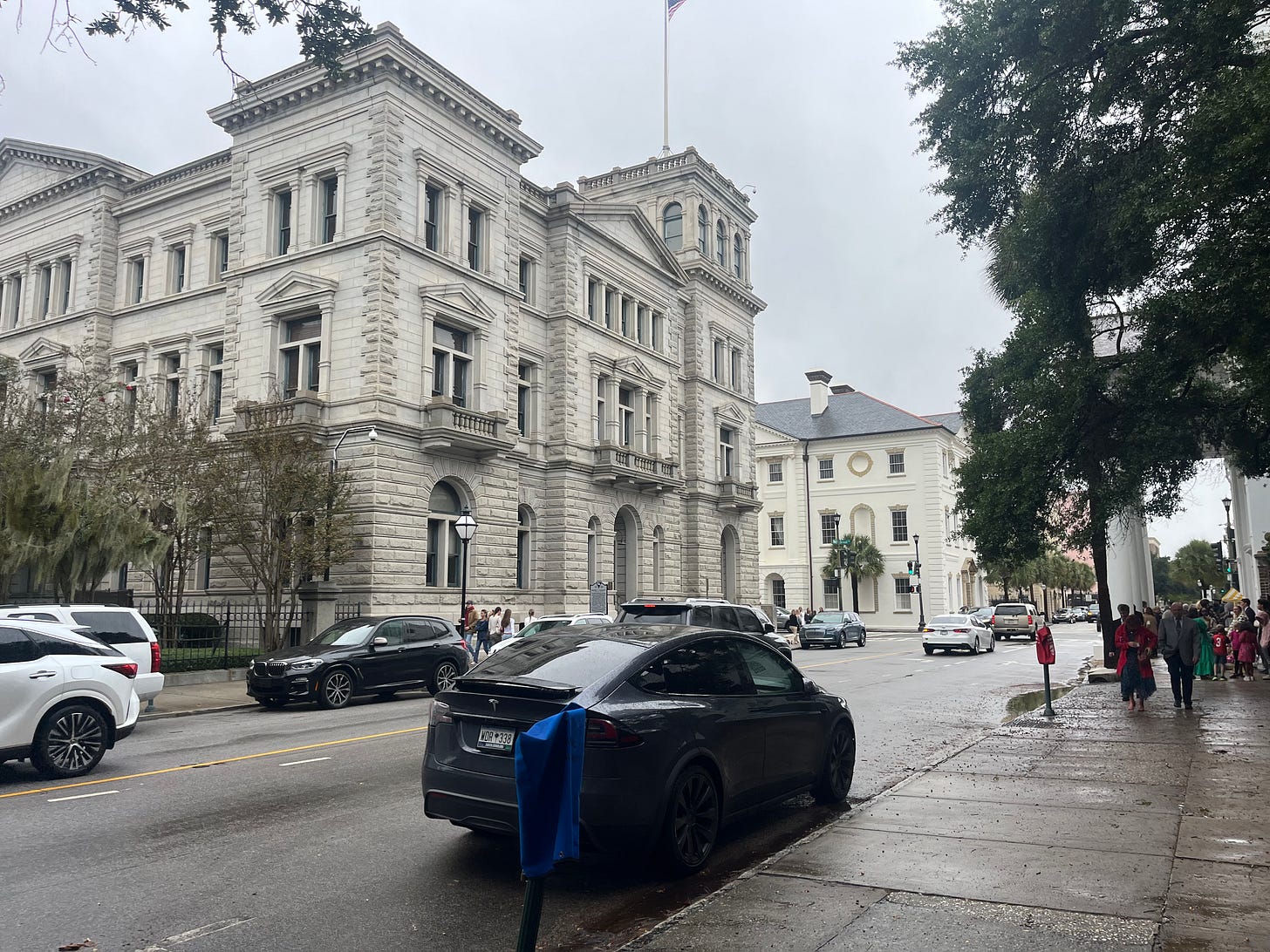
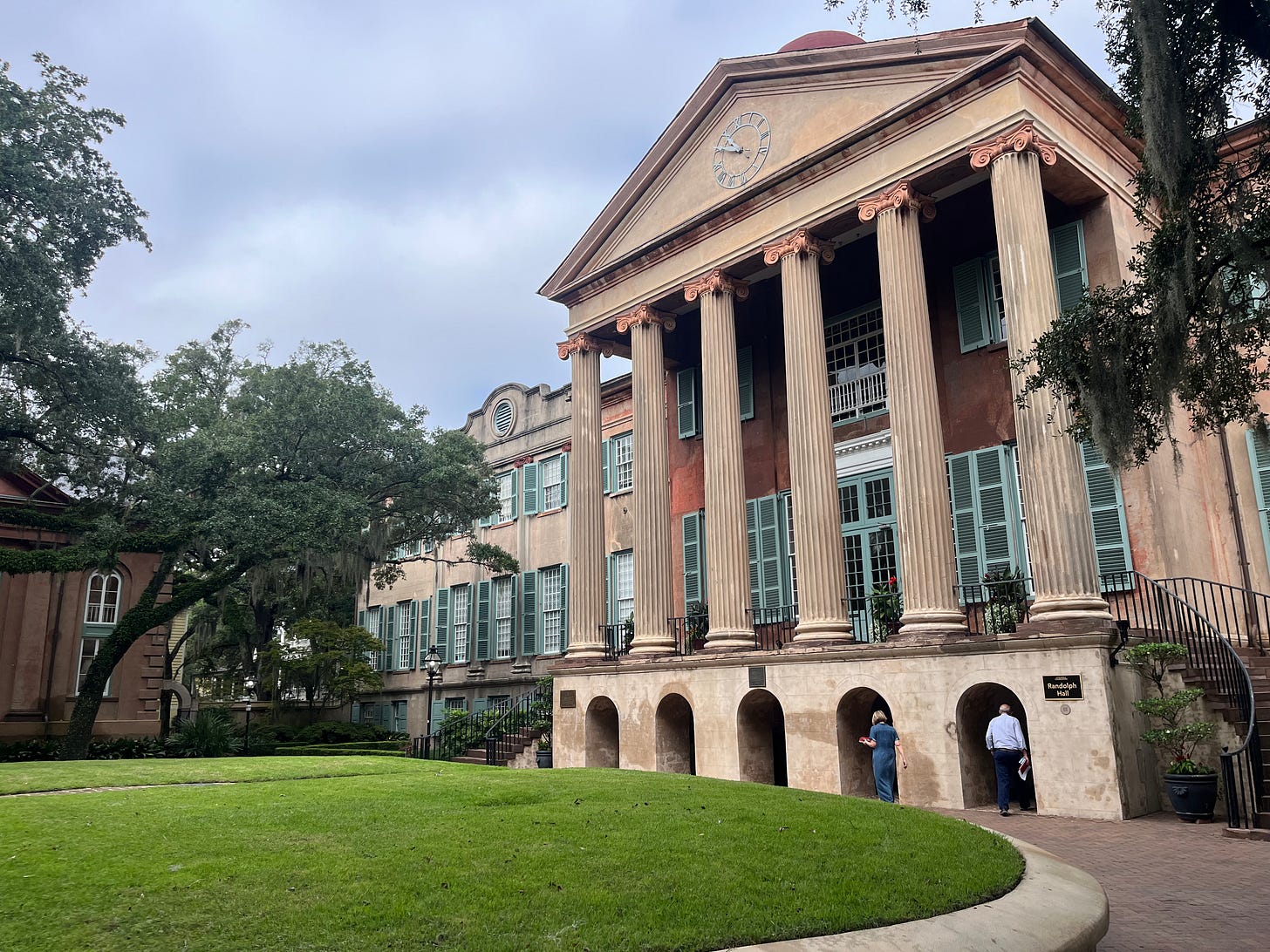
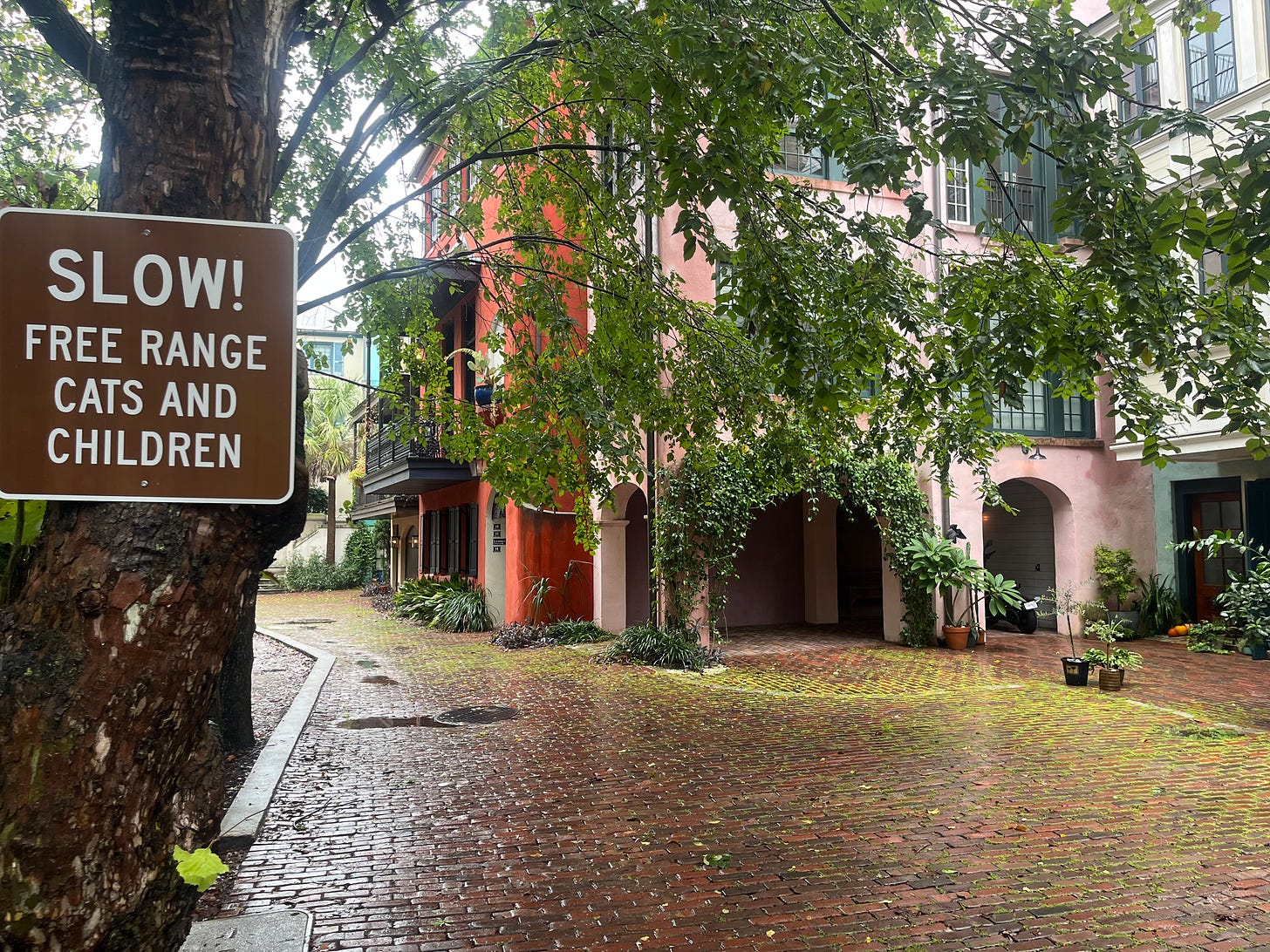
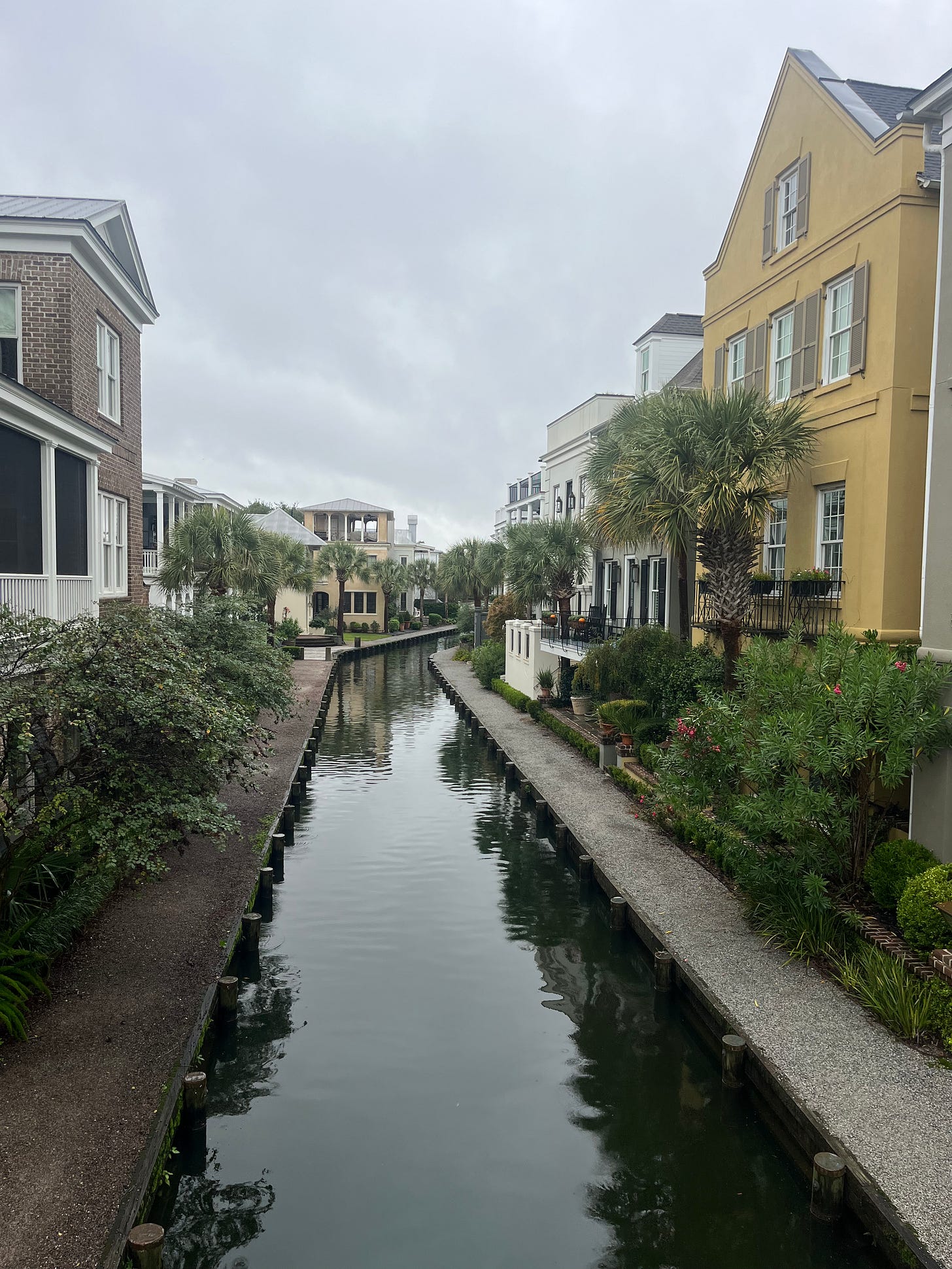

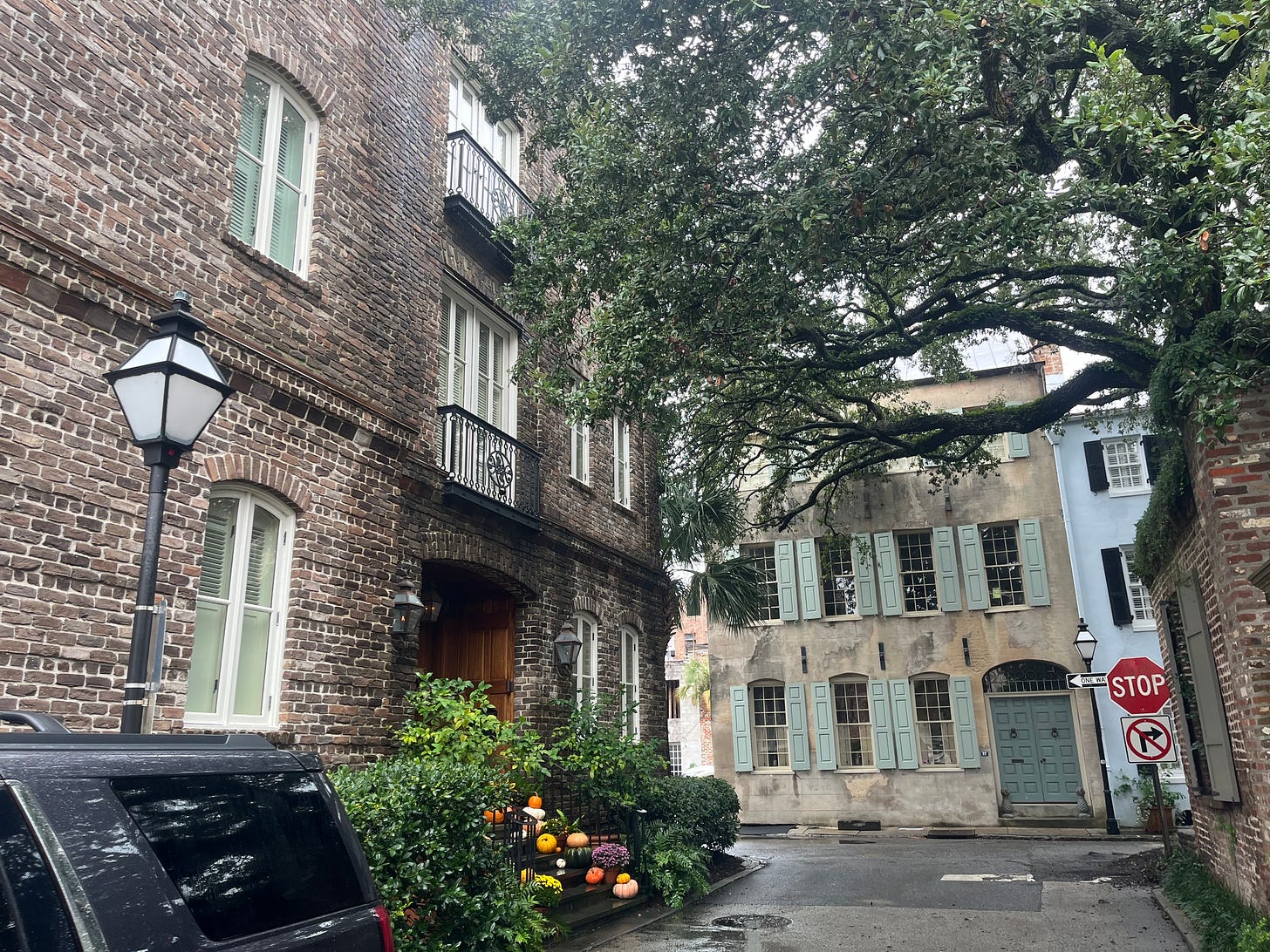
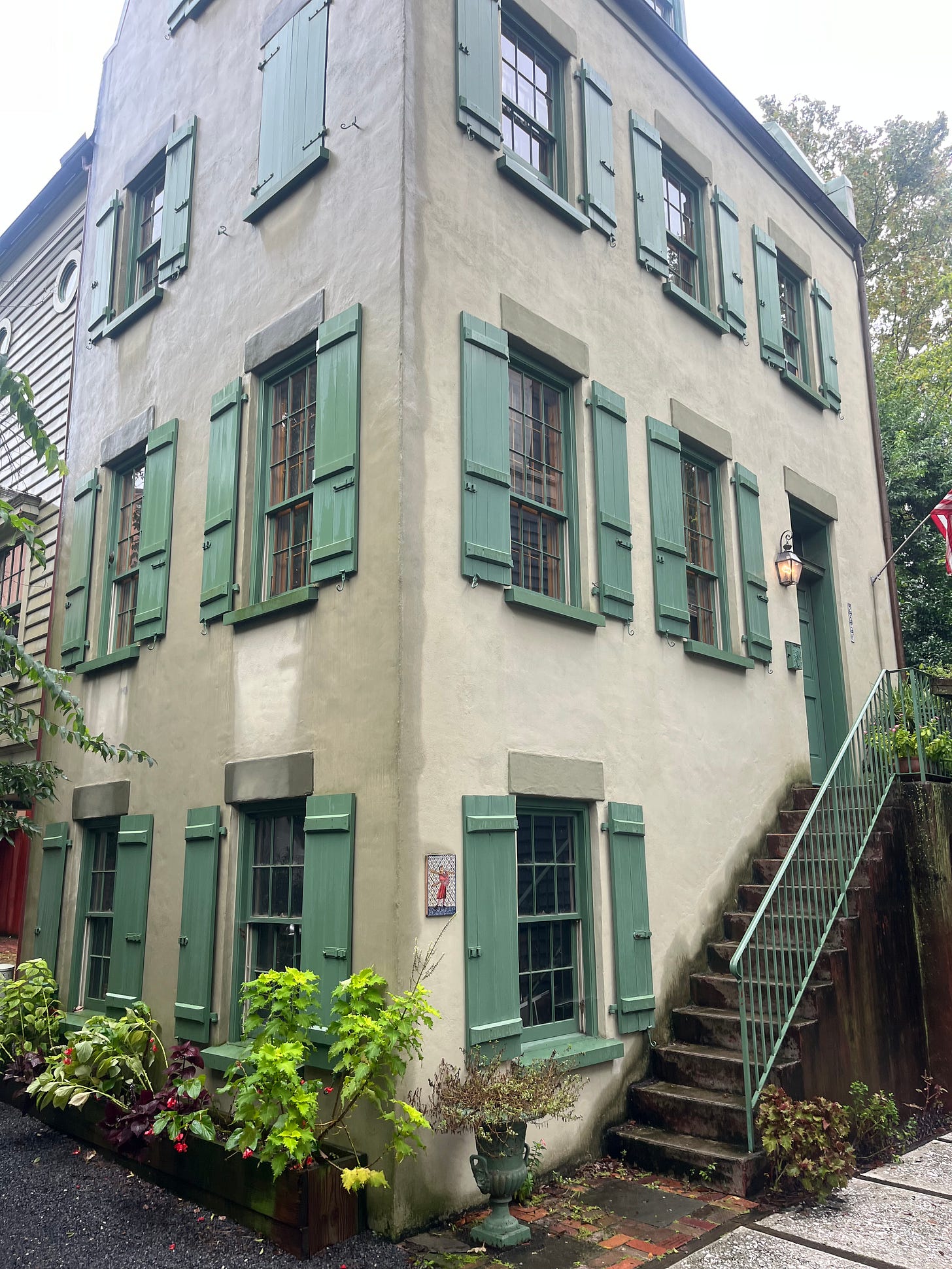
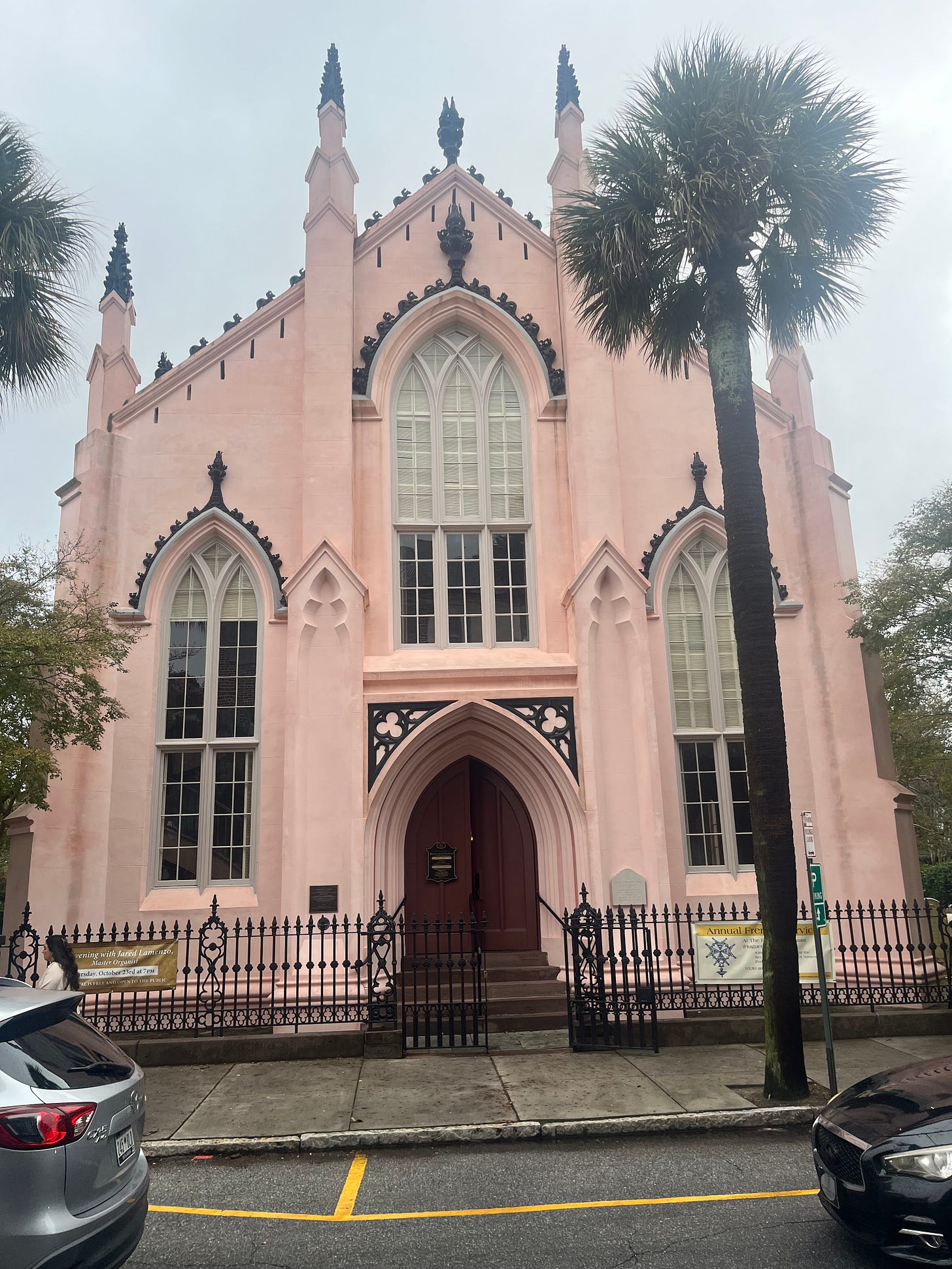
Savannah, Georgia where we lived for a few years is (arguably) just as nice. It has a well maintained old part of the city with scenic squares and 18th century houses. Like Charleston, it has a terrific restaurant scene. So, put Savannah on your list for your next visit.
The most attractive American cities are generally ones that are surrounded by water so builders were forced to go up rather than out and thereby create the density that fosters true urbanity. Elsewhere, the abundance of land combined with the ubiquity of cars encouraged low rise sprawl.